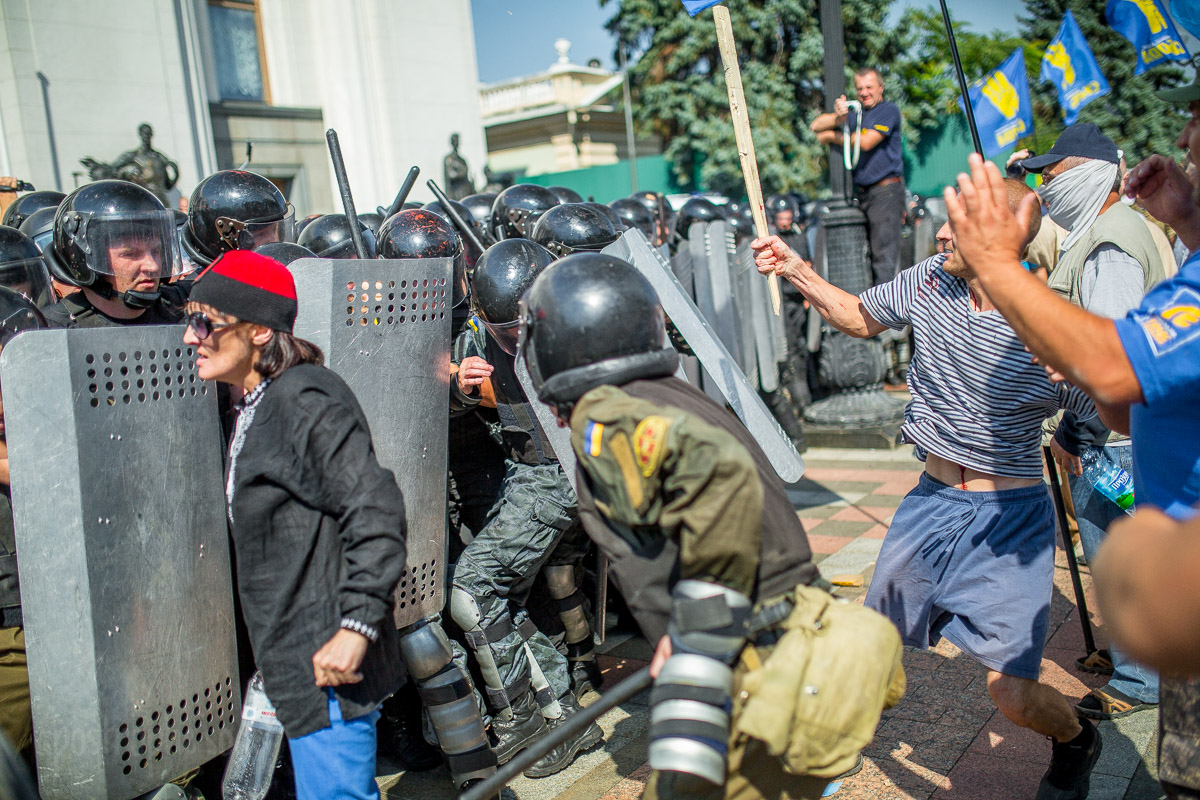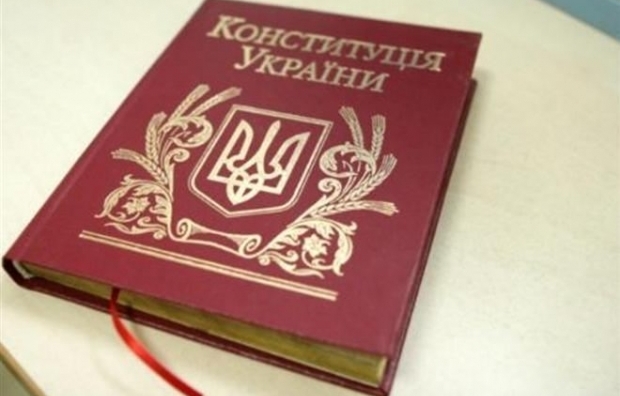
In addition, Ukraine is a neighbor of the largest state in terms of territory - the Russian Federation, which has not come to terms with the existence of independent Ukraine and is doing everything to destroy the Ukrainian state using a full range of available means - from information propaganda aimed at creating a sense of "acquired inability", to the establishment and support of separatist organizations and outright aggression.
It is unrealistic to resist the pressure of Russia by military methods alone. As long as the Russian Federation is convinced of the weakness of the Ukrainian authorities and the factor of inter-regional tensions, it will continue to attempt our destruction. Even a powerful army is weak if it has a weak rear. Our rear is not only and not so much the political parties and their actions but, above all, regions and relations between regions and the center.
Territorial dimension of Ukraine: past and present

Until recently, the territorial dimension of Ukraine was considered either in its simplest form (Right Bank and Left Bank), or more complex form classified as follows: Western Ukraine - from the Zbruch River and beyond to the western border; Central Ukraine - from Khmelnytskyi to Poltava and from Zhytomyr to Kirovohrad; Eastern Ukraine - Kharkiv, Donetsk, Luhansk, Zaporizhzhia oblasts; Southern Ukraine - Kherson, Mykolaiv, Odesa oblasts and the Autonomous Republic of Crimea. At the same time, no one doubted that Eastern Ukraine is the most developed, urbanized region and one that defines the vector of Ukraine's movement. However, the events of 2014 showed that, in fact, the situation with the identification of inter-regional differences and the impact of regions on the nationwide vector has changed significantly. Russia also understands this, which is why it is increasing the pressure on Ukraine.
Recent History.
The 2014 events were made possible through the absence of real cohesion policy in Ukraine for 28 years rather than through Maidan.
The beginning of the stirring up of inter-regional problems dates back to the early 1990s in Crimea, the region that later became part of the Ukrainian SSR. It was the weakest element in the Ukrainian state space, the only region where Ukrainians were a minority in the population and where the Russian army and navy were stationed.
The mid-1990s in Crimea was a very hectic period, which is illustrated by the first very serious attempt to tear Crimea off from Ukraine. It didn't work out then. More or less consolidated Ukrainian authorities were able to eliminate the visible part of the problem in 1994-1995 using the weakness of the pro-Russian organizations of the time, internal contradictions between them, in particular between their leaders (then ARC Verkhovna Rada Chairperson Serhii Tsekov and ARC President Yurii Mieshkov), low activity of Russia, which hoped to invade the whole territory of Ukraine in a few years in addition to Crimea. Mieshkov was removed from office, the position of President of Crimea was abolished, additional units of the National Guard were deployed in Crimea.
After the fiasco in Crimea, Russia began to play the long game in other Ukrainian territories. Pro-Russian organizations were formed in various Ukrainian cities and regions, political parties such as the CPU, PSPU, ZUBR, the Russian Bloc, etc. - began to infiltrate local councils. Civic movements such as the “Ukrainian Choice” began to openly promote the idea of “federalization” of Ukraine, and in fact - weakening the state and turning it into a vassal “Russian Ukraine”. Along with these rather marginal "parties", the Party of Regions appeared, which appeared to be a more moderate Russian-focused force, and it became the most acceptable for the regional elites of Eastern and Southern Ukraine.
The 2004 Maidan frightened the supporters of the Russian focus so much that the "Southeast Congress in Sievierodonetsk" was held. It was the first, very serious, attempt to alienate a part of the Ukrainian territory. Fortunately, this did not happen back then, the parties to the conflict calmed down, none of the directors and participants of this action was punished. This might have become a signal for future separatist speeches: it is necessary to prepare better, and if it fails, there will be no punishment for the participants.
For the first time, the 2004 election introduced the idea of different varieties of Ukraine and the West and East divide.
The 2005-2010 period was characterized by different trends in Ukraine. But on the whole, everything seemed peaceful. This may be why more and more alarming signals from the regions were ignored by the Ukrainian authorities. Work on the destruction of state institutions has increased dramatically. Local councils elected in 2006 begun to adopt openly anti-state decisions - declaring Russian as an official/regional language; vote of no confidence in the CSA heads immediately after the council was formed in the absence of legal grounds; decisions on a ban for NATO ships to call at ports; declaring the region as neutral and non-aligned, and so on.
All decisions were left unanswered by the state authorities, local councils were not dissolved, which continued to give rise to a sense of permissiveness. At the same time, different movements of “territorial communities” began to emerge in 2005–2010, another viral technology that preached the idea that Ukrainians might not be citizens but simply “people”: can create “territorial communities” and elect bodies that are not part of the public authorities of Ukraine but at the same time replace those bodies.
In order to blur Ukrainian citizenship, these self-styled “territorial communities” began to issue their “human passports”, business registration certificates, car registration plates, and even created their own security structures. At the same time, various public initiatives on Novorosiia and the DNR emerge. Participation of leaders of such marginalized groups in various events in the Russian Federation, in particular in Seliger, seemed to be an element of ordinary propaganda, but within a few years, these leaders were in charge of the seizure of power in the east of Ukraine.
In 2013–2014, the map of inter-regional disunity was again used by a variety of pro-Russian forces, which led to an attempt to overthrow the Ukrainian authorities in the key cities of eastern and southern Ukraine. Fortunately, Ukrainian citizens were able to stop the invasion of “people's republics” by their decisive steps in Dnipro, Kharkiv, Zaporizhzhia, Odesa.
War in Donbas. 22 February 2014 can be referred to as the official start of the separatist rebellion in Ukraine. On that day, a congress of MPs and local councilors of all levels from the southeastern regions and the ARC took place in Kharkiv. Not only local councilors , but also heads of Luhansk, Dnipropetrovsk, Donetsk and Kharkiv regional administrations, who were supposed to represent the state executive power and were responsible for the observance of the Constitution and laws of Ukraine, the mayor of Sevastopol, governors of Rostov-on-Don, Don, Voronezh and Belgorod participated in the congress, which is generally beyond comprehension.
Several decisions were adopted at the congress, including the delegation of a local authority to local self-government bodies "until the constitutional order and legality in the country are restored, the work of central authorities is legitimized". The local population was encouraged by the congress to "organize themselves to engage with the law enforcement on the ground", in fact, create "self-defense" that played a key disguising role in Crimea and the Donbas.
Next, we saw the seizure of government buildings, creation of "self-defense", pseudo-referendums and war, which in fact started on April 13, 2014, when a group of Ukrainian officers, one of whom was killed, ran into an ambush and were shot up. Ukraine embarked on reforms in 2014 in the face of severe economic exhaustion, the loss of Crimea and violent military confrontation in Donbas. All the above inevitably left a mark on the content, pace, and possibilities of financing reforms, in particular, decentralization reform and reform of national regional policy, which most affect the cohesion of the state.
Positive Steps in 2014–2016
Right after Maidan 2014 and the formation of the new Government, a number of steps were taken that brought the state's attention back to the issue of cohesion, solidarity of society, creation of conditions for “stitching” Ukraine back together.
First, despite the start of hostilities in Donbas, the decentralization process has begun. On April 1, 2014, Government Decree No. 333-p “On Approval of the Concept of Local Self-Government Reform and Territorial Organization of Government” was adopted. Despite external pressure and internal problems, the delegation of powers and allocation of budget resources began to be carried out to territorial communities of the cities of regional significance, newly formed Amalgamated Territorial Communities (ATCs), rather than at the regional level.
This was a very important step for the cohesion of the state, as each new territorial community, which had direct relations with the State Budget of Ukraine, became a new chain from the Center to the region. A new practice of partnerships between neighboring communities that have entered into territorial communities cooperation agreements started in Ukraine. The creation of ATCs and the execution of cooperation agreements creates a network of vertical and horizontal links between state and territorial communities in Ukraine bypassing the regional level. In terms of its nature, it leans towards politicization, which can turn into separatism. This is how Ukraine is stitched together.
All the above was made possible through the adoption of several very important laws in 2014-2015: "On Voluntary Amalgamation of Territorial Communities", "On Cooperation between Territorial Communities" and amendments to the Budget Code of Ukraine on the reform of intergovernmental budgetary relations.
Second, there have been major changes in the development and implementation of national regional policy and strategic planning for regional development. In 2014-2015, two strategically important documents were adopted - the Law "On the Principles of State Regional Policy" and the State Strategy for Regional Development for the Period up to 2020, in which the unity of the Ukrainian space was determined by the strategic task of the state regional policy for the first time. A politically neutral and predictable mechanism for financing regional development at the expense of the State Regional Development Fund, which should be formed at the rate of 1% of the State Budget of Ukraine, has also been launched. In general, from a regulatory point of view, the situation regarding the development of a new state regional policy based on the cohesion of the Ukrainian space looks rather good. However, in 2017-2019, a kind of the declared policy "rollback" began.
Current Situation
What you need to know and understand in 2019.
The Ukrainian jurisdiction does not cover the ARC and the most populated parts of Donetsk and Luhansk oblasts. Along the demarcation line, there is a limited capacity area for the activities of entrepreneurs and local self-governments (in particular, due to landmines). The areas close to the border with the Russian Federation suffer from the actual cessation of transit across the border, stagnation of local entrepreneurship and accelerated population decline.
A significant proportion of the more than one and a half million internally displaced persons (IDPs) is mostly located in Kharkiv, Dnipropetrovsk, Zaporizhzhia, and Kyiv oblasts. Resettlement of IDPs outside the Donetsk and Luhansk oblasts indicates a low likelihood of these people returning to their place of permanent residence, even after the liberation of these territories. Most TV channels are not just opposed to the Ukrainian authorities, but also to the Ukrainian state (the situation has not changed even after the election of a new president). In addition, the level of trust in public authorities is extremely low, indicating Ukraine's vulnerability to external pressure and internal turmoil. In 2019, the situation in Ukraine in terms of the country's stable development and containment of centrifugal processes and external threats is difficult, though not as critical as in 2014. However, the 2019 election campaign can significantly worsen the situation.
National and Regional Identities
The cohesion of Ukraine is impossible without an understanding of Ukrainian identity. Today, identity is again at the forefront not only here. How do the terms "European" and "Polish", "Ukrainian" and "Odesa Resident" compare? Where are strength and weakness? Shared identity unites and strengthens, while its blurring weakens. Domination of regional identity over Ukrainian identity (in Crimea and Donbas) has already played a dirty trick on Ukraine in 2014, so stimulating this process is extremely dangerous today. Facts corroborated by Rating's December 2018 Sociological Survey: the identity of residents of the territories controlled by Ukraine and that of the residents of the occupied territories differs significantly; an identity similar to Russian is formed in the occupied territories; such a new identity becomes a fact, and each year of occupation increasingly delimits Ukrainian and this new territorial identity.
Regional "separatism" After the separatist congress in Kharkiv on 22 February 2014 and the subsequent bloodshed in Donbas, regional separatism, or rather attempts to isolate regional authorities, would seem to be a thing of the past. But it fell through. The system of local self-government bodies in Ukraine is built so that the regional council is a party-representative local self-government body of regional level with a rather limited range of powers and without its own executive body. In fact, the responsibility of the executive body of the regional council is exercised by the respective RSA. In general, such a model was intended as a precaution to regional separatism. But it is offset by the proportional elections of the regional councilors, allocation of the part of state taxes and fees for the regional level of local self-government, the right of the regional council to move a motion of no-confidence in the head of the regional state administration.
Today, regional councils are not ready to fulfill their key mission - regional development planning. Instead, they have become policy-making bodies beyond their own competence: from the prohibition of the use of the language of the aggressor country in the territory to the requirements for the transition to contractual relations "between the Region and Kyiv" (Zakarpattia, Odesa, Ivano-Frankivsk, Khmelnytskyi, Kirovohrad, Kyiv, Poltava).
Such decisions verge on regional separatism. Their sad consequences could be far greater if the regional councils had their own executive bodies charged with implementing the decisions adopted. These decisions have again been ignored by the state authorities, which has set a precedent, and local councils continue to adopt decisions beyond their powers, thus undermining Ukrainian legal space. Appropriate state oversight over the decisions, actions, and omissions of local self-government regarding legality is imperative. More than 90% of residents of territorial communities support the introduction of oversight, as evidenced by a December 2018 study by the Council of Europe in Ukraine. Now, several parties running for election are using the federation slogan that triggered the bloodshed in 2014.
Ukrainian Solidarity/Cohesion
The State Regional Development Strategy for the Period up to 2020 defined the strategic goal of implementing the state regional policy - “creation of conditions for the dynamic, balanced development of the regions of Ukraine in order to ensure social and economic unity of the state”. Therefore, state programs and projects should have been implemented in 2014-2018 to achieve this strategic goal. Unfortunately, due to a misunderstanding by the Ukrainian political elite of the importance of the unity of the state in confronting an external enemy and internal challenges, such programs have not been developed or implemented. It is only through budget support from the European Union that the national regional development program “All-Ukrainian Solidarity” was prepared and funded in 2018.
Problem areas. Cohesion has a number of synonyms - not only unity, consolidation but also union, involvement in something common. Therefore, we consider cohesion not only as a key element of national regional policy and state stability but also as an important component for the region, the territorial community (especially the amalgamated one), the convergence of different social, ethnic and other groups.
It is no secret that within even rather prosperous regions there are territories that have naturally limited development opportunities: for example, poor accessibility highlands; territories whose development is complicated by new factors - decline in a previously dominant industry or industry, close proximity to a war zone or a closed state border. Separate state support instruments must be developed for each type of territory: from income tax benefits to newly established legal entities that meet the preset characteristics - to state risk insurance for enterprises operating in certain problem areas.
The influence of the state on the improvement of the situation in the problem territories in the regions will be another element stitching the Ukrainian space together. The state needs to exhibit attention to problems that cannot be solved within the territorial community or even the region.
The history of Ukraine in general and in recent decades, in particular, shows that the lack of integration of the Ukrainian space, separatist manifestations, weakness of the state institutions, total distrust is the cause of increased pressure on Ukraine by the Russian Federation and threatens the national security of Ukraine and Ukrainians.
The decentralization of power in Ukraine, launched in 2014, without its speedy completion until the new local election in 2020, can turn from the possibility for development and cohesion of the state to the threat of increasing asymmetry in the development of individual communities and territories. And thus lead to another spiral of tension. Adoption of the Law on the Framework of the Administrative-Territorial Structure will become vital in 2019.
At the same time, single and uniform implementation of Ukrainian legislation throughout the country, as well as determination of the method of state oversight over decisions, actions and omissions of local self-government bodies as soon as possible and bringing them to responsibility for violations of their own powers is important for the sake of preserving the unity of the Ukrainian space.
Starting the implementation of the state regional development strategy through the State Regional Development Programs, in particular, the program "All-Ukrainian Solidarity", is an extremely important step for Ukraine's cohesion. It will become possible provided that Article 24-1 of the Budget Code is amended accordingly, which will increase the size of the State Regional Development Fund to 1.5% of the State Budget revenues and help use one-third of these funds to the implementation of national regional development programs.
Regulation of issues of developing "problem territories", determining mechanisms of their identification and tools of state support for development requires rapid amendments to the laws: "On the Principles of State Regional Policy", "On Encouraging Regional Development", "On State Assistance" and related amendments to the Tax and Customs Codes of Ukraine. Territories with limited potential for development should not be left unnoticed by the state.
Any steps of the state concerning Ukraine's cohesion will not yield any result under the conditions of total dominance in the information sphere of negative information concerning the situation in Ukraine, an attempt to oppose different groups of citizens and regions. Therefore, the communication policy of the state has to be substantially changed. Bodies and officials have to explain their plans and actions to Ukrainian citizens, develop mechanisms for citizen engagement in discussing draft decisions, and use the expertise of Ukrainian think tanks and NGOs for this purpose. There is a need for constructive political discourse in the information space of Ukraine regarding the ways to unite Ukraine, the Ukrainian space, avoiding aggressive opposition of communities and regions in the political fight.
Read also:
- Ukraine’s main challenge: to solve its identity crisis
- Ukraine’s Eurointegration drags feet without EU membership perspectives
- Why Ukraine must avoid the Transnistrian scenario
- Five years of Poroshenko’s presidency: main achievements and failures
- Ukraine’s largest civil society reform coalition marks fifth anniversary, braces for elections
- Decentralization reform can be Ukraine’s success, if it doesn’t stop halfway
- Decentralization: the mortal threat to Ukraine’s entrenched elites
- Ukraine’s decentralization and Donbas “special status”: what you need to know
- Moscow-forced decentralization of Ukraine seen involving real risks
- “Republics” — Kremlin’s Trojan horse in Ukraine





